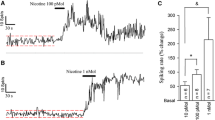Summary
In the nigrostriatal pathway, dopamine is released not only from striatal nerve terminals, but also locally from the dendrites of nigrostriatal neurones within the substantia nigra itself. Exogenous dopamine is known to inhibit the firing of these neurones when applied directly to the substantia nigra in micromolar concentrations: but the amounts used are probably much higher than the endogenous concentration of the transmitter. Moreover, the direct, local blockade of nigral dopamine autoreceptors has not been reported to affect the firing rates of these neurones. The electrophysiological effects of endogenous dopamine were therefore examined using intracellular recordings from the substantia nigra in vitro. When slices of the midbrain were pharmacologically depleted of endogenous dopamine, selective membrane properties of nigrostriatal neurones were altered in a manner consistent with the effects of the exogenous transmitter. Similar changes were observed in control slices on exposure to the dopamine antagonist haloperidol. It is concluded that endogenous dopamine normally exerts a tonic influence on the electrical properties of nigrostriatal neurones.
Similar content being viewed by others
References
Aghajanian GK, Bunney BS (1973) Central dopaminergic neurones: neurophysiological identification and responses to drugs. In: Usdin E, Snyder S (eds) Frontiers in catecholamine research. Pergamon, Oxford London, pp 643–648
Boarder MR, Fillenz M (1979) Absence of increased tyrosine hydroxylation after induction of brain tyrosine hydroxylase following reserpine administration. Biochem Pharmacol 28: 1675–1677
Bunney BS, Aghajanian GK, Roth RH (1973) Comparison of effects of L-dopa, amphetamine and apomorphine of firing rate of rat dopaminergic neurons. Nature New Biol 245: 123–125
Burn JH, Rand MJ (1960) The effect of precursors of noradrenaline on the response to tyrosine and sympathetic stimulation. Br J Pharmacol 15: 47–55
Cheramy A, Leviel V, Glowinski J (1981) Dendritic release of dopamine in the substantia nigra. Nature 289: 537–542
Geffen LB, Jessel TM, Cuello AC, Iversen LL (1976) Release of dopamine from dendrites in rat substantia nigra. Nature 260: 258–260
Gonon GG (1988) Nonlinear relationship between impulse flow and dopamine released by rat midbrain dopaminergic neurons as studied by in vivo electrochemistry. Neuroscience 24: 19–28
Grace AA, Bunney GS (1983) Intracellular and extracellular electrophysiology of nigral dopaminergic neurons. I. Identification and characterization. Neuroscience 10: 333–348
Greenfield SA, Grunewald RA, Foley P, Shaw SG (1983) Origin of various enzymes released from the substantia nigra and caudate nucleus: effects of 6-hydroxydopamine lesions of the nigro-striatal pathway. J Comp Neurol 214: 87–92
Kita T, Kita H, Kitai ST (1986) Electrical membrane properties of rat substantia nigra compacta neurons in an in vitro slice preparation. Brain Res 372: 21–30
Lacey MG, Mercuri NB, North RA (1987) Dopamine acts on D2 receptors to increase potassium conductance in neurons of the rat substantia nigra zona compacta. J Physiol 392: 397–416
Leviel V, Cheramy A, Glowinski J (1979) Role of the dendritic release of dopamine in the reciprocal control of the two nigrostriatal dopaminergic pathways. Nature 280: 236–239
Llinás R, Greenfield SA, Jahnsen HJ (1984) Electro-physiology of pars compacta cells in the in vitro substantia nigra — a possible mechanism for dendritic release. Brain Res 294: 127–132
Marchetti C, Carbone E, Lux HD (1986) Effects of dopamine and noradrenaline on Ca2+ channels of cultured sensory and sympathetic neurons of chick. Pflügers Arch 406: 104–111
Nedergaard S, Hopkins C, Greenfield SA (1988a) Do nigrostriatal neurons possess a discrete dendritic modulatory mechanism? Electrophysiological evidence from the actions of amphetamine in brain slices. Exp Brain Res 69: 444–448
Nedergaard S, Bolam JP, Greenfield SA (1988b) Facilitation of a dendritic calcium conductance by 5-hydroxytryptamine in the substantia nigra. Nature 333: 174–177
Pinnock RD (1983) Sensitivity of compacta neurones in the rat substantia nigra slice to dopamine agonists. Eur J Pharmacol 96: 269–276
Pinnock RD (1984) The actions of antipsychotic drugs on dopamine receptors in the rat substantia nigra. Br J Pharmacol 81: 631–635
Author information
Authors and Affiliations
Rights and permissions
About this article
Cite this article
Kapoor, R., Webb, C. & Greenfield, S.A. Endogenous dopamine modifies electroresponsiveness of pars compacta cells in the guinea pig substantia nigra in vitro. Exp Brain Res 74, 653–657 (1989). https://doi.org/10.1007/BF00247370
Received:
Accepted:
Issue Date:
DOI: https://doi.org/10.1007/BF00247370




